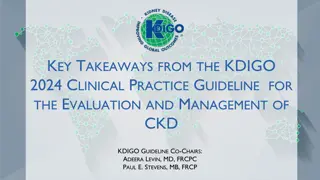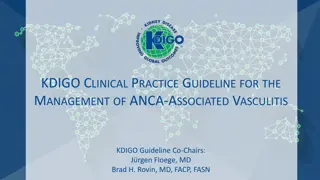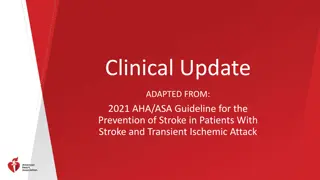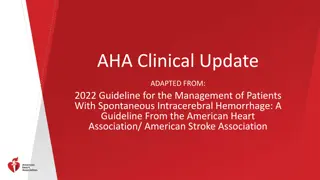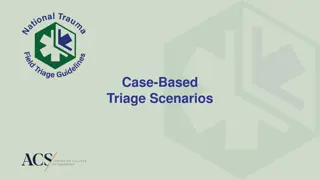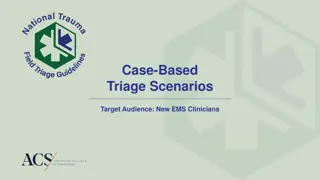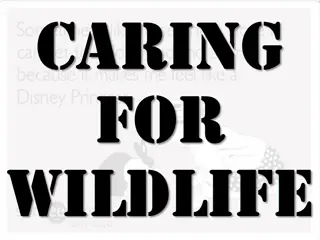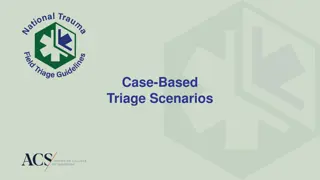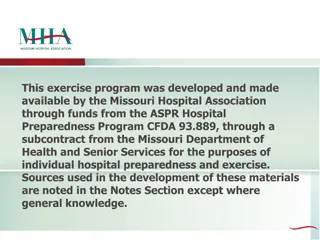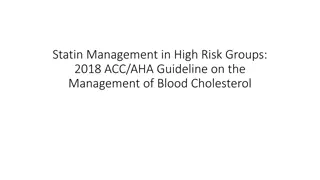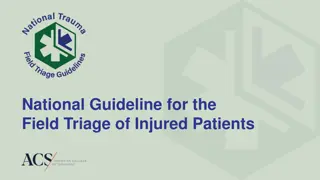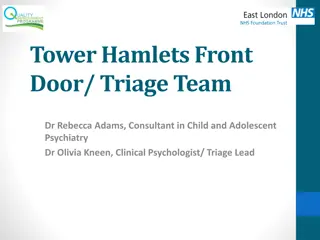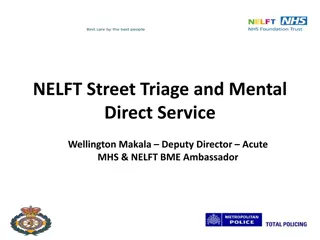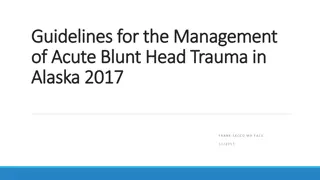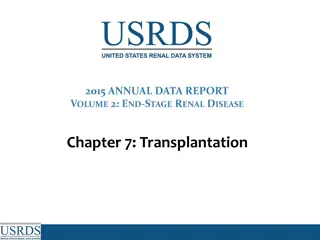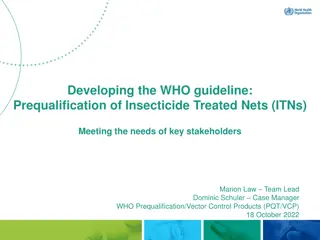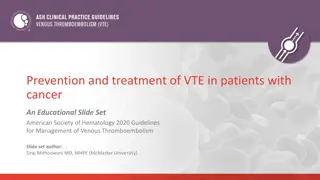Field Triage Guidelines Update 2021: National Guideline for Injured Patients
The 2021 update of trauma triage guidelines aims to streamline destination decisions for injured patients. The new guideline emphasizes assessing vital signs, mechanisms of injury, and special considerations to ensure optimal patient outcomes. Key objectives include describing the update process, explaining the new guideline, and discussing changes from the 2011 version. By following local protocols and medical director guidance, EMS and trauma systems can minimize variation in destination decisions and achieve the right patient, right place, right time transport. The update process involved input from EMS stakeholders and rigorous reviews to enhance decision-making criteria. The revised guideline focuses on aligning information flow with EMS assessments to expedite transport decisions and reduce under- and over-triage.
Download Presentation

Please find below an Image/Link to download the presentation.
The content on the website is provided AS IS for your information and personal use only. It may not be sold, licensed, or shared on other websites without obtaining consent from the author. Download presentation by click this link. If you encounter any issues during the download, it is possible that the publisher has removed the file from their server.
E N D
Presentation Transcript
Trauma Triage Guidelines Update 2021 National Guideline for the Field Triage of Injured Pts Adopted by WI Trauma System and WI EMS in 2022
National Guideline for the Field Triage of Injured Patients
Objectives Describe the update process Explain the new Guideline Discuss the changes from the 2011 Guideline Review local & regional use of the Guideline
Remember Follow your local protocol & medical director guidance
Why a guideline? Achieve optimal patient outcomes through transport to most appropriate destination within the trauma system Right Patient, Right Place, Right Time Minimize variation in destination decisions
Why an update? New research and evidence since 2011 Guideline Reduce time and variation in making destination decisions Opportunity to reduce under- & over-triage
Update Process Inclusion of EMS input Survey distributed to 29 national organizations representing EMS and trauma 3,958 Responses Interdisciplinary national Expert Panel Systematic reviews of EMS field triage and other relevant published literature Rigorous process for adding or removing criteria
2011 Guideline 1. Assess vital signs & level of consciousness 2. Assess anatomy of injury 3. Assess mechanism of injury & evidence of high energy impact 4. Assess special patient or system considerations
Whats new? Not an algorithm Simplified to align with information flow to EMS Reflect how assessments occur on the scene Gets to transport decision sooner
New Guideline Flow of information to EMS Risk Guideline is intended to be read from left to right and top to bottom Evidence along gradient of likelihood for serious injury
Age-related changes to vital signs have been added Source: Getty Images. Used with permission
Extrication relates to entrapment, not simple confinement
Applying the Guideline Appreciate and understand the context Know your local and regional trauma resources Encourage adoption by local and state EMS agencies Sustain education and training Track use and outcomes through performance improvement
Transport According to Local Protocol Source: Getty Images. Used with permission
Summary Update process inclusive of EMS clinician input New guideline aligns with information flow to EMS and how assessments occur on the scene Guideline use is best assessed through impact on under- & over-triage rates
Case-Based Triage Scenarios Target Audience: New EMS Clinicians
These case-based scenarios have been developed as an educational training tool to illustrate application of the National Guideline for the Field Triage of Injured Patients. EMS and trauma systems vary significantly across the US. These cases include hypothetical system resources from a mix of urban, suburban, and rural community scenarios. Attention should be given to how the availability of different resources may influence your decision making.
In each scenario there will be one patient to assess and make a triage decision. The Field Triage Guideline was developed using the best available evidence to identify patients that are most likely to benefit from the resources of a trauma center. They are not meant to supersede local trauma triage protocols and are not intended for mass casualty incident (MCI) triage.
VALDERS CASE 2A System & Resources: Rural transport ambulance. Level II trauma center 30-40 min transport, Level III trauma center 20 min transport, community hospital 20 min transport. Air transport on scene 20 min from request. Dispatch Info: Two-car MVC, one car over embankment. You and a second unit are dispatched. Scene Size Up: Sedan over embankment, damage as shown. Young female restrained driver responding but confined by damaged door. Air bags deployed. Door is popped by rescue & patient able to self-extricate. Primary survey: A Yelling for help, answers questions B Regular, non-laboredwing commands, agitated about wreck 112/68 HR 96 RR 18 SpO2 99% RA GCS 15 History None Source: Mark Gestring, MD FACS. Used with permission Initial Thoughts?
CASE 2A System & Resources: Rural transport ambulance. Level II trauma center 30-40 min transport, Level III trauma center 20 min transport, community hospital 20 min transport. Air transport on scene 20 min from request. Dispatch Info: Two-car MVC, one car over embankment. You and a second unit are dispatched. Scene Size Up: Sedan over embankment, damage as shown. Young female restrained driver responding but confined by damaged door. Air bags deployed. Door is popped by rescue & patient able to self-extricate. Primary Survey: A Yelling for help, answers questions B Regular, non-labored C Regular radial pulse, warm skin D Following commands, agitated about wreck Secondary survey: Exam Scattered small facial & arm lacs from glass, obviously deformed right shin with bruisin Source: Mark Gestring, MD FACS. Used with permission Patient Destination?
CASE 2A System & Resources: Rural transport ambulance. Level II trauma center 30-40 min transport, Level III trauma center 20 min transport, community hospital 20 min transport. Air transport on scene 20 min from request. Dispatch Info: Two-car MVC, one car over embankment. You and a second unit are dispatched. Scene Size Up: Sedan over embankment, damage as shown. Young female restrained driver responding but confined by damaged door. Air bags deployed. Door is popped by rescue & patient able to self-extricate. Primary Survey: A Yelling for help, answers questions B Regular, non-labored C Regular radial pulse, warm skin D Following commands, agitated about wreck Secondary Survey: Exam Scattered small facial & arm lacs from glass, bilateral shins with bruising Initial vital signs BP 112/68 HR 96 RR 18 SpO2 99% RA GCS M 6 History None Source: Mark Gestring, MD FACS. Used with permission Changes to Your Plan?
VALDERS CASE 2B System & Resources: Rural transport ambulance. Level II trauma center 30-40 min transport, Level III trauma center 20 min transport, community hospital 20 min transport. Air transport on scene 20 min from request. Dispatch Info: Two-car MVC, one car over embankment. You and a second unit are dispatched. Scene Size Up: Sedan over embankment resting on side as shown. Young female restrained driver responding but lower extremities entrapped under dash. Rescue removes the roof and performs dash roll to extricate patient, takes ~25 minutes to get patient out. Primary survey: A Yelling for help, answers questions B Regular, non-labored C Regular radial pulse, warm skin D Following comma nds, agitated about wreck 99% RA GCS 15 History None Source: Mark Gestring, MD FACS. Used with permission Initial Thoughts?
CASE 2B System & Resources: Rural transport ambulance. Level II trauma center 30-40 min transport, Level III trauma center 20 min transport, community hospital 20 min transport. Air transport on scene 20 min from request. Dispatch Info: Two-car MVC, one car over embankment. You and a second unit are dispatched. Scene Size Up: Sedan over embankment resting on side as shown. Young female restrained driver responding but lower extremities entrapped under dash. Rescue removes the roof and performs dash roll to extricate patient, takes ~25 minutes to get patient out. Primary Survey: A Yelling for help, answers questions B Regular, non-labored C Regular radial pulse, warm skin D Following commands, agitated about wreck deformed right shin with bruising Initial vital signs BP 112/68 HR 96 RR 18 SpO2 99% RA GCS 15 History None Source: Mark Gestring, MD FACS. Used with permission Patient Destination?
CASE 2B System & Resources: Rural transport ambulance. Level II trauma center 30-40 min transport, Level III trauma center 20 min transport, community hospital 20 min transport. Air transport on scene 20 min from request. Dispatch Info: Two-car MVC, one car over embankment. You and a second unit are dispatched. Scene Size Up: Sedan over embankment resting on side as shown. Young female restrained driver responding but lower extremities entrapped under dash. Rescue removes the roof and performs dash roll to extricate patient, takes ~25 minutes to get patient out. Primary Survey: A Yelling for help, answers questions B Regular, non-labored C Regular radial pulse, warm skin D Following commands, agitated about wreck Secondary Survey: Exam Scattered small facial & arm lacs from glass, bilateral shins with bruising Initial vital signs BP 112/68 HR 96 RR 18 SpO2 99% RA GCS M 6 History None Changes to Your Plan? Source: Mark Gestring, MD FACS. Used with permission
VALDERS CASE 4B System & Resources: Rural transport ambulance. Level II trauma center 30-40 min transport, Level III trauma center 20 min transport, community hospital 20 min transport. Air transport on scene 20 min from request. Dispatch Info: Elderly male ground level fall. Scene Size Up: Elderly male lying on ground near couch. Lives alone. Primary survey: A Answers questions B Regular, non-labored C Regular radial pulse, warm skin D Following commands, oriented to person, place. States he tripped on rug Secondary survey: Exam Large hematoma on left forehead with small overlying skin tear. Multiple bruises on both arms, some appear old.Coumadin) Source: Getty Images. Used with permission Initial Thoughts?
CASE 4B System & Resources: Rural transport ambulance. Level II trauma center 30-40 min transport, Level III trauma center 20 min transport, community hospital 20 min transport. Air transport on scene 20 min from request. Dispatch Info: Elderly male ground level fall. Scene Size Up: Elderly male lying on ground near couch. Lives alone. Primary Survey: A Answers questions B Regular, non-labored C Regular radial pulse, warm skin D Following commands, oriented to person, place. States he tripped on rug Source: Getty Images. Used with permission Secondary survey: Patient Destination?
CASE 4B System & Resources: Rural transport ambulance. Level II trauma center 30-40 min transport, Level III trauma center 20 min transport, community hospital 20 min transport. Air transport on scene 20 min from request. Dispatch Info: Elderly male ground level fall. Scene Size Up: Elderly male lying on ground near couch. Lives alone. Primary Survey: A Answers questions B Regular, non-labored C Regular radial pulse, warm skin D Following commands, oriented to person, place. States he tripped on rug Source: Getty Images. Used with permission Secondary Survey: Exam Large hematoma on left forehead with small overlying skin tear. Multiple bruises on both arms, some appear old. Initial vital signs BP 168/84 HR 84 RR 12 SpO2 96% RA GCS M 6 History CAD, HTN, OA, afib. On warfarin (Coumadin) Changes to Your Plan?
VALDERS CASE 6 System & Resources: Rural transport ambulance. Level II trauma center 30-40 min transport, Level III trauma center 20 min transport, community hospital 20 min transport. Air transport on scene 20 min from request. Dispatch Info: Male fell off ladder. Scene Size Up: Middle aged male lying supine on concrete driveway, ladder lying next to him near 2 story roof. Source: Getty Images. Used with permission Initial Thoughts?
CASE 6 System & Resources: Rural transport ambulance. Level II trauma center 30-40 min transport, Level III trauma center 20 min transport, community hospital 20 min transport. Air transport on scene 20 min from request. Dispatch Info: Male fell off ladder. Scene Size Up: Middle aged male lying supine on concrete driveway, ladder lying next to him near 2 story roof. Primary Survey: A Answers questions B Regular, non-labored C Regular radial pulse, warm skin D Following commands. States up working on roof eaves and ladder gave out. Source: Getty Images. Used with permission Patient Destination?
CASE 6 System & Resources: Rural transport ambulance. Level II trauma center 30-40 min transport, Level III trauma center 20 min transport, community hospital 20 min transport. Air transport on scene 20 min from request. Dispatch Info: Male fell off ladder. Scene Size Up: Middle aged male lying supine on concrete driveway, ladder lying next to him near 2 story roof. Primary Survey: A Answers questions B Regular, non-labored C Regular radial pulse, warm skin D Following commands. States up working on roof eaves and ladder gave out. Secondary Survey: Exam Hematoma to occiput. Cannot move lower extremities, states they are numb. Full strength in upper extremities. No obvious lower extremity deformities. Initial vital BP 152/110 HR 70 RR 22 SpO2 98% RA GCS M 6 History HTN, CAD, CABGx2 Changes to Your Plan? Source: Getty Images. Used with permission
You have seen how resource availability can impact triage, patient destination, and transport mode decisions. It is important to understand the local EMS and trauma system resources where you practice. Trauma centers of each level and transport time/distance Local non-trauma center hospitals Air medical services and time to request & arrive on scene Other ambulance coverage & need for mutual aid Geographic constraints or other unique resources and challenges


